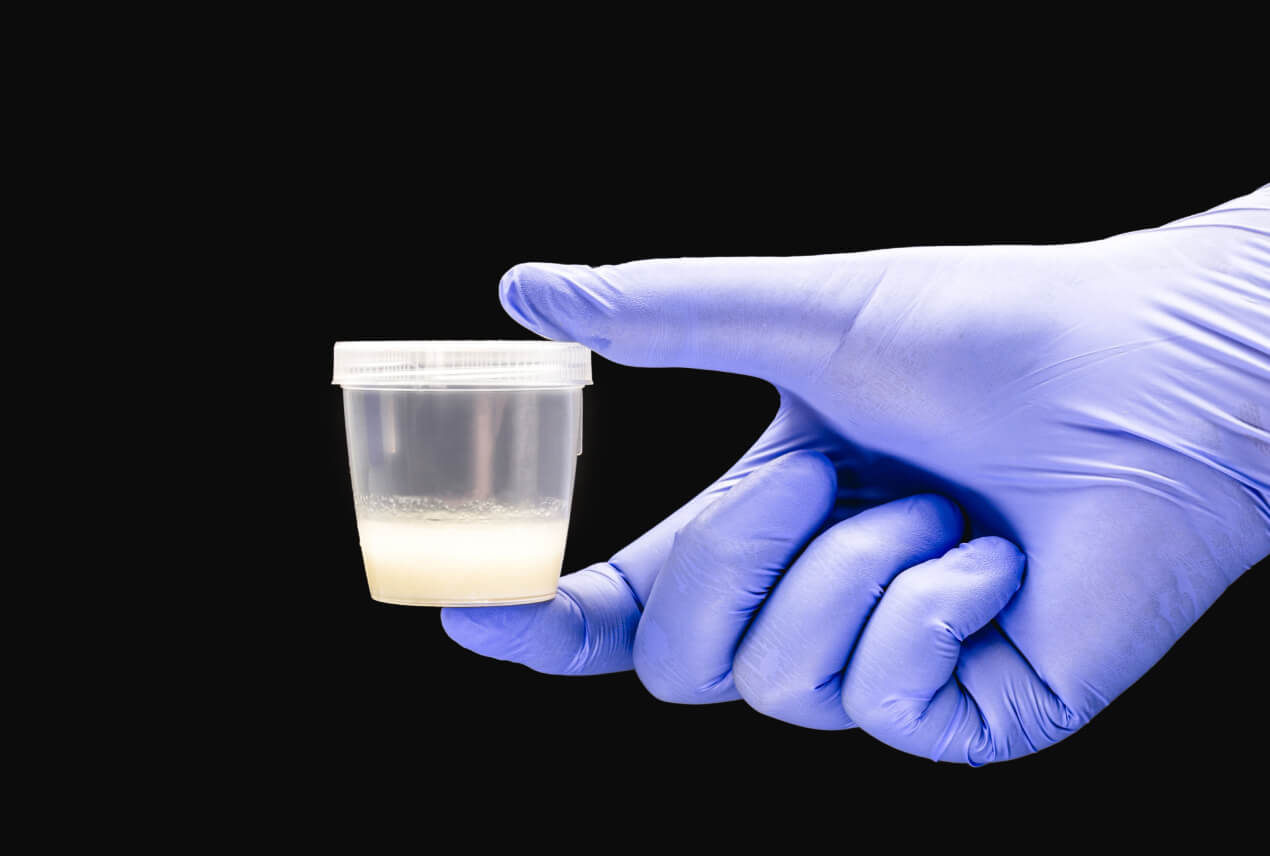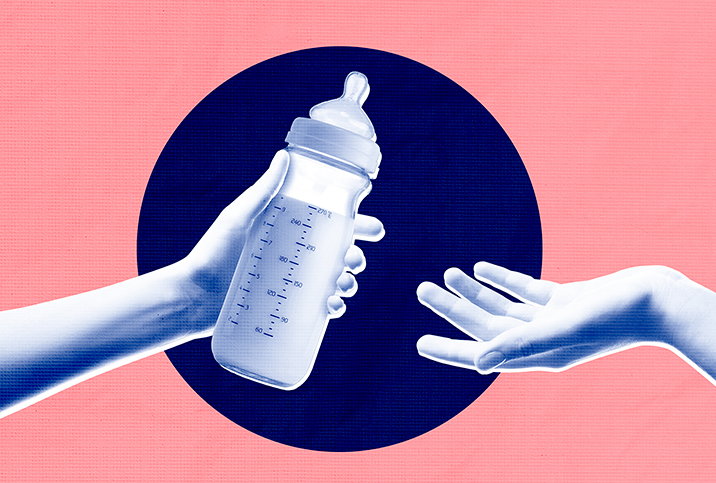When a man ejaculates, he typically releases 1.5 to 5 milliliters of semen, of which sperm is only a small component.
The Facts About Semen
Find out how semen affects your sexual health.

What is semen?
Semen is a thick, whitish, pearlescent fluid produced in the male reproductive organs that contains sperm, among other substances. It is typically ejaculated through the urethra out of the man's penis and can fertilize a female ovum, or egg, resulting in pregnancy.
The sperm "swims" in the fluid. The design of the human body is such that sperm is meant to be deposited deep within the woman's vagina. From there, it has the shortest distance possible to move into the uterus and connect with an egg to begin reproduction.
What's in semen?
Semen is primarily the vehicle for delivering the man's genetic material—sperm—to the woman's ovum, or egg, in order to reproduce. However, sperm makes up a tiny percentage of the total volume of semen.
The sperm are secreted from the testes and account for about 2 percent to 5 percent of semen. That's despite somewhere between 200 million and 500 million individual sperm cells being released in each ejaculation. The seminal vesicles produce a liquid that makes up about 65 percent to 75 percent of semen, which contains fructose, amino acids, citrate, enzymes, proteins and vitamin C.
The prostate gland contributes 25 percent to 30 percent of the volume of semen. The prostatic fluid is a liquid that contains acid phosphate, prostate-specific antigen, citric acid and zinc. The bulbourethral glands contribute less than 1 percent of the volume of semen. This fluid contains galactose, mucus, preejaculate and sialic acid.
Semen versus sperm
Sometimes people use the terms semen and sperm interchangeably, but they are not the same substance. Sperm is typically in semen, but semen is made up of many other ingredients.
It's important to note this difference because it is possible for semen to contain no sperm. This condition is called azoospermia and can occur when a man has had a procedure called a vasectomy that severs the tubes that carry the sperm from the testicles.
Sperm, or spermatozoa, is the name for the microscopic cells that carry the man's DNA. They swim using the powerful motion of their tails, whereas semen is the fluid that contains the sperm. One useful way to remember the difference is to think of semen as the delivery system for the sperm, which are the packets that contain the man's genetic information.
What does semen do?
Semen is designed to carry sperm deep into the vagina in order to meet up with an ovum, or egg, and fertilize it, resulting in pregnancy. It contains fluids that feed, nurture and protect the sperm so they can survive long enough to make the journey to the woman's uterus. Semen also offsets the vagina's acidity, which further protects the sperm.
The process of the man's ejaculation pushes the semen deep into the vagina, where the first part remains relatively liquid, allowing the sperm to continue swimming toward the uterus. The final part of the semen tends to coagulate into a thicker consistency—perhaps to help keep the semen in place longer—before it liquefies in about 15 to 30 minutes.
How is semen produced?
The male reproductive system produces semen from a variety of sources. Sperm is created in the testes, the male gonads that reside in the scrotum, beginning the process of maturation over 50 to 60 days. The sperm exit the testicles and mature as they make a journey of about 14 more days along tightly coiled, squiggly tubes called the epididymis. They remain in the epididymis until the man ejaculates. At that moment, the sperm pass into the vasa deferentia, a pair of tubes that connect the epididymis to the urethra.
Another part of the male reproductive system, the seminal vesicles, are sac-like glands that sit behind the bladder and produce the majority of semen. The prostate gland also produces a small part of the semen.
Semen consistency
The consistency of a person's semen can vary greatly depending on their diet, how much water they drink, how long it's been since they ejaculated, their age, their testosterone levels and more.
For instance, if you're dehydrated, your semen may be thicker and clumpy, almost chunky. But unless it's accompanied by other issues—discoloration or a foul odor, for instance—thicker semen usually isn't anything to worry about. In fact, thicker semen, also known as hyperviscosity, is found in 12 percent to 29 percent of males, according to studies.
Semen consistency changes over time after it leaves the man's body. It usually begins as a viscous, grayish-white, pearlescent substance that grows more watery and liquefied within about 30 minutes.
How is semen analysis performed?
Semen analysis is usually undertaken as part of fertility testing or as a follow-up procedure a few months after a vasectomy to make sure no sperm are leaving the testes. If someone is planning a family, and especially if a couple is having trouble getting pregnant, it helps to know the details of the man's ejaculate. A semen sample can be used to test for the following:
- pH level (how acidic the semen is)
- Semen volume (how much semen the man produces)
- Sperm concentration or sperm count (how many sperm are present)
- Sperm morphology (the shape and size of the sperm)
- Sperm motility (how well the sperm can move)
- Time to liquefaction (how long it takes for the semen to liquefy)
- Vitality (the percentage of living sperm present)
At-home testing kits are available, but using a professional lab to do the analysis usually brings more accurate results.
Can you be allergic to semen?
Yes, you can be allergic to semen. A small percentage of women have been diagnosed with human seminal plasma hypersensitivity, a condition of being allergic to a protein that's found in their partner's semen. Some of the symptoms include genital itching, blisters and redness. It affects only about 40,000 people in the entire United States, so be aware that a whole host of other conditions share those symptoms.
Interestingly, a man's body can react to his own sperm as though he were "allergic" to it. Occasionally, especially following a vasectomy, a man may develop antisperm antibodies that target sperm, which the body sees as foreign invaders.
Is semen healthy?
If your partner is healthy and doesn't have any sexually transmitted infections (STIs) or diseases (STDs), there is nothing inherently unhealthy about swallowing semen. On the other hand, headline-grabbing "studies" that claim swallowing semen is the same as taking a multivitamin or getting a facial with semen is good for your skin are almost universally exaggerated.
Swallowing semen is unlikely to extend your life span or help your cognitive function in any measurable way. But there's nothing particularly unhealthy about it, either—as long as your partner doesn't have any STDs. Diseases such as gonorrhea, chlamydia and syphilis are transmittable through mucous membranes like those in your throat, nostrils and eyes.
What is semen retention?
Semen retention is a practice in which men choose not to ejaculate for a period of time for purported physical and mental health benefits. Videos on social media claim semen retention may help guys with maintaining focus, generating more testosterone, gaining confidence, clearing up their skin and more.
Those, and a whole host of other dubious claims, are largely unsupported by science or even common sense. For instance, one paper that's frequently cited as a source for claims that semen retention increases testosterone was retracted. While deciding not to ejaculate for a time isn't likely to do you any harm, it almost certainly doesn't offer most—perhaps any—of the benefits semen retention enthusiasts claim.
FAQs
How is semen produced?
Semen production begins in the man's testes, where sperm are created, maturing over the course of 50 to 60 days. They then continue maturing as they pass through tightly coiled tubes above the testicles called the epididymis. After about 14 more days on this journey, they mature and remain in the epididymis until they pass into the vasa deferentia, a pair of tubes that connect the epididymis to the urethra, during ejaculation. When the man is ready to ejaculate, glands called the seminal vesicles produce more fluid, about 65 percent to 70 percent of the semen. The prostate also produces a small amount of fluid. All of this fluid is combined as the process of ejaculation begins and is forced along the man's urethra and out of his penis.
How is semen analysis performed?
To check the quality of a man's semen and sperm, he is asked to produce a sample in a doctor's office or for a home testing kit. The analysis should include the following parameters:
- pH level (how acidic the semen is)
- Semen volume (how much semen the man produces)
- Sperm concentration or sperm count (how many sperm are present)
- Sperm morphology (the shape and size of the sperm)
- Sperm motility (how well the sperm can move)
- Time to liquefaction (how long it takes for the semen to liquefy)
- Vitality (the percentage of living sperm present)
With this information, a men's fertility specialist can help him to understand any issues, the viability of his sperm and if he can expect any problems reproducing.
Who performs semen analysis?
While there are at-home testing kits that can provide some information, semen samples are best analyzed in professional labs that specialize in semen analysis. Healthcare providers who are trained to handle samples and use research-based methods to analyze semen are most likely to provide the most accurate, comprehensive information. If possible, choose a fertility clinic or lab that does a high volume of semen analysis to avoid errors.












